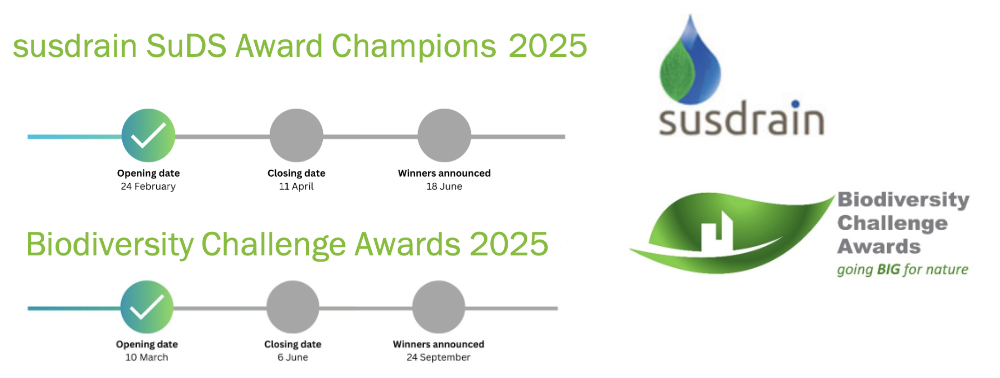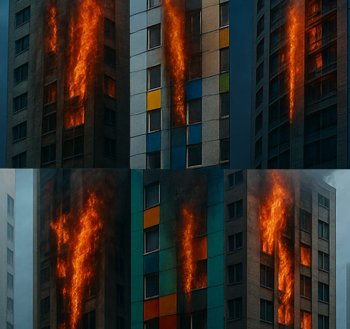Understanding and celebrating Sustainable Urban Drainage and Biodiversity
Contents |
[edit]
Development can lead to significant changes in natural hydrological systems, often resulting in increased flooding, water pollution, and habitat destruction. Sustainable Urban Drainage Systems (SuDS) offer an innovative approach to managing storm water, with the potential to enhance biodiversity. SuDS systems can mimic slower natural processes, providing not only flood control systems, reduced pollution, and in some cases improved water quality, but also supporting local wildlife habitats.
Blue-green infrastructure is a term that highlights some of the crossovers between water systems and biodiversity. As described by the NHCB Foundation, blue-green infrastructure refers to: ‘naturally occurring or created water bodies incorporated into urban design in conjunction with SuDS features. When in combination with green infrastructure referred to as blue-green infrastructure’ (Biodiversity in new housing developments: creating wildlife-friendly communities, published April 2021) The importance of competence in these areas of professionalism cannot be understated, as highlighted in the competence framework published with the edge for the Construction Industry Council (CIC), referring to blue infrastructure as ‘infrastructure elements and connections including rivers, canals, ponds, wetlands, floodplains, and water treatment facilities.’ (Competence frameworks for the built environment – Core criteria for sustainability competence - Code of practice , Version 3, February 2025)
[edit] Celebrating Sustainable urban drainage and Biodiversity projects
Since 2018 the Susdrain SuDS Award Champions has been recognising individuals and teams who driving good practice in sustainable drainage (SuDS). Since 2013 in a similar light, the Biodiversity Challenge Awards has been championing people and projects who deliver differences to enhance biodiversity, going BIG for biodiversity.
[edit] Biodiversity Challenge Awards 2025
CIRIA’s Biodiversity Community of Practice is pleased to announce that the Biodiversity Challenge Awards 2025 are officially open, they are free to enter and open until 6 June, 2025.
The Biodiversity Challenge Awards encourage the construction industry to ‘go BIG for nature’ by putting biodiversity at the centre of projects to deliver beyond normal business practice and compliance with applicable legislation such as BNG in England. The winners will be announced at the awards ceremony on 24 September 2025.
Melissa Ralph, Green Infrastructure for Growth - Project Lead, Cormac; former Biodiversity Champion and former Judging Panel Chair commented "It is vital that the UK and global construction industry actively encourage biodiversity at all stages of project delivery. We must act boldly to create more space for wildlife, healthier ecosystems, and richer landscapes. The 2025 CIRIA Biodiversity Challenge Awards have been revitalised to reflect the national introduction of Biodiversity Net Gain (BNG) and are a great opportunity to reflect on your project team’s success, impact, and legacy."
For further information about the awards and how to enter visit Biodiversity Challenge Awards 2025 – Open for entries!
[edit] Susdrain SuDS Award Champions for 2025
CIRIA and Sustrain have announced that the susdrain SuDS Champions Awards 2025 are officially open, they are free to enter and open until 11 April, 2025.
These awards recognise individuals and teams who are driving good practice in sustainable drainage (SuDS) forward, tackling flooding, enhancing biodiversity, and transforming urban spaces. Various awards including: the early career Rising Star award, the established professional and for an outstanding team driving collaboration and innovation. The awards cover the whole of the UK, including Scotland and Northern Ireland, and include professionals in construction, local authorities, and community-led initiatives. The winners will be announced at the awards ceremony on 18 June 2025.
For further information about the awards and how to enter visit: Nominate your susdrain SuDS Award Champions for 2025
[edit] Examples highlighting the relationship between SuDS and biodiversity
Green Roofs or planted on rooftops, act as a natural sponge for rainwater. These systems reduce surface run-off by absorbing and slowly releasing water. Additionally, they create habitats for pollinators like bees and butterflies, as well as birds and small mammals. They contribute to urban biodiversity by introducing plant species that attract insects, forming small but crucial ecosystems in city landscapes.
Traditional impermeable surfaces exacerbate urban flooding by preventing water infiltration. Permeable pavements, including porous asphalt, permeable concrete, and interlocking pavers, allow water to filter through to underlying layers, replenishing groundwater reserves. This helps reduce urban run-off, preventing water pollution in nearby rivers and lakes, indirectly benefitting biodiversity and aquatic ecosystems.
Rain gardens are shallow, planted depressions designed to absorb and filter rainwater run-off from roads, rooftops, and pavements. These gardens use native plants that require minimal maintenance and provide habitat for birds, insects, and amphibians. The diverse plant species improve air quality and attract pollinators, enhancing urban biodiversity while reducing water pollution.
Constructed Wetlands serve as natural water treatment systems, using plants, soil, and microorganisms to remove pollutants from storm water before it enters natural water bodies. These wetlands offer a crucial habitat for wetland species, including amphibians, birds, and insects. By restoring natural wetland functions, constructed wetlands support biodiversity and help mitigate the impact of urbanisation on local ecosystems.
Swales are shallow, vegetated channels that transport and filter run-off, while bioswales enhance this process with engineered soil and additional vegetation. These systems slow down storm water flow, allowing for sediment deposition and pollutant removal. Swales provide habitat for insects, birds, and small mammals, contributing to urban biodiversity while preventing erosion and improving water quality.
Detention and retention basins temporarily hold excess storm water and release it slowly, reducing flood risk, while retention basins store water permanently to support aquatic ecosystems. These basins create mini-reservoirs that attract wetland species, including fish, amphibians, and waterfowl. The presence of standing water promotes the growth of native aquatic plants, fostering biodiversity and improving ecological balance.
[edit] Related articles on Designing Buildings
- Achieving sustainable clean water infrastructure for all.
- Biodiversity net gain.
- Biodiversity net gain with related updates and terms explained.
- Blackwater.
- Blue belt.
- Blue roof.
- Blue space.
- Catchment flood management plans.
- Dewatering.
- Drainage.
- Eutrophication.
- Flood.
- Flood and Water Management Act.
- Flood insurance.
- Flood risk.
- Flood risk management plan.
- Floodscape.
- Future flood prevention.
- Future Water, The Government’s water strategy for England.
- Green infrastructure.
- Green roof.
- Greywater.
- Groundwater control in urban areas.
- Highway drainage.
- Infrastructure.
- London's Blue Ribbon Network.
- Pitt Review.
- Planning for floods.
- Preston flood scheme completes primary school SuDS projects.
- Pumps and dewatering equipment.
- Rainwater harvesting.
- River engineering.
- Sewer construction.
- Sewerage.
- Soakaway.
- SuDS infographic.
- Surface water
- Sustainable urban drainage systems SUDS.
- Sustainable urban drainage systems - latest guidance.
- Sustainable water.
- Swales definition.
- Sustainable urban drainage systems SUDS.
- The SuDS Manual.
- Water Act 2014.
- Water consumption.
- Water engineering.
- Water transfers and interconnections.
- Why creating new ponds helps to protect the ecosystem.
Featured articles and news
Delivering for tenants; National Retrofit Hub
New report offers recommendations to strengthen energy efficiency standards to protect private renters.
Government consultations for the summer of 2025
A year of Labour, past and present consultations on the environment, the built environment, training and tax.
CMA competitiveness probe of major housing developers
100 million affordable housing contributions committed with further consultation published.
Homes England supports Greencore Homes
42 new build affordable sustainable homes in Oxfordshire.
Zero carbon social housing: unlocking brownfield potential
Seven ZEDpod strategies for brownfield housing success.
CIOB report; a blueprint for SDGs and the built environment
Pairing the Sustainable Development Goals with projects.
Types, tests, standards and fires relating to external cladding
Brief descriptions with an extensive list of fires for review.
Latest Build UK Building Safety Regime explainer published
Key elements in one short, now updated document.
UKGBC launch the UK Climate Resilience Roadmap
First guidance of its kind on direct climate impacts for the built environment and how it can adapt.
CLC Health, Safety and Wellbeing Strategy 2025
Launched by the Minister for Industry to look at fatalities on site, improving mental health and other issues.
One of the most impressive Victorian architects. Book review.
Common Assessment Standard now with building safety
New CAS update now includes mandatory building safety questions.
RTPI leader to become new CIOB Chief Executive Officer
Dr Victoria Hills MRTPI, FICE to take over after Caroline Gumble’s departure.
Social and affordable housing, a long term plan for delivery
The “Delivering a Decade of Renewal for Social and Affordable Housing” strategy sets out future path.
A change to adoptive architecture
Effects of global weather warming on architectural detailing, material choice and human interaction.
The proposed publicly owned and backed subsidiary of Homes England, to facilitate new homes.
How big is the problem and what can we do to mitigate the effects?
Overheating guidance and tools for building designers
A number of cool guides to help with the heat.
The UK's Modern Industrial Strategy: A 10 year plan
Previous consultation criticism, current key elements and general support with some persisting reservations.
Building Safety Regulator reforms
New roles, new staff and a new fast track service pave the way for a single construction regulator.


























